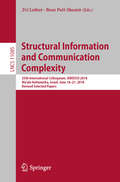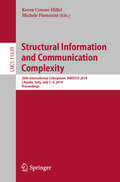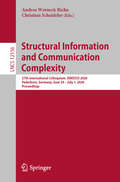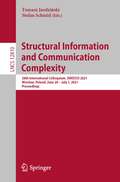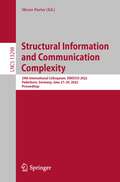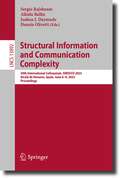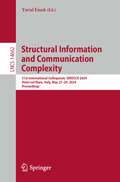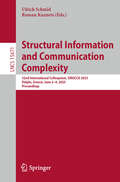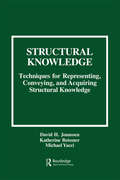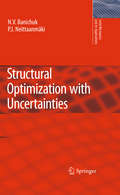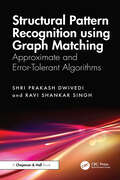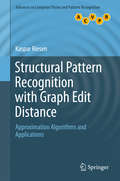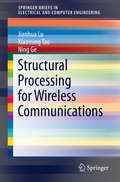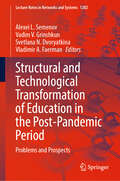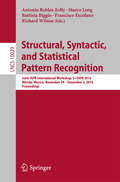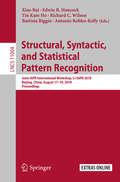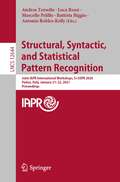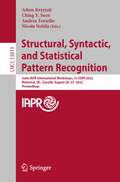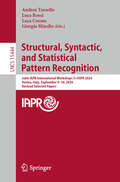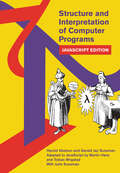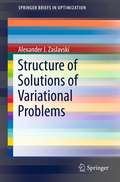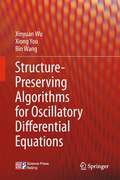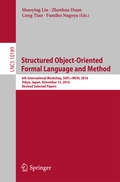- Table View
- List View
Structural Information and Communication Complexity: 25th International Colloquium, SIROCCO 2018, Ma'ale HaHamisha, Israel, June 18-21, 2018, Revised Selected Papers (Lecture Notes in Computer Science #11085)
by Zvi Lotker Boaz Patt-ShamirThis book constitutes the refereed post-conference proceedings of the 25th International Colloquium on Structural Information and Communication Complexity, SIROCCO 2018, held in Ma'ale HaHamisha, Israel, in June 2018. The 23 full papers and 8 short papers presented were carefully reviewed and selected from 47 submissions. They are devoted to the study of the interplay between structural knowledge, communications, and computing in decentralized systems of multiple communicating entities and cover a large range of topics.
Structural Information and Communication Complexity: 26th International Colloquium, SIROCCO 2019, L'Aquila, Italy, July 1–4, 2019, Proceedings (Lecture Notes in Computer Science #11639)
by Michele Flammini Keren Censor-HillelThis book constitutes the refereed conference proceedings of the 26th International Colloquium on Structural Information and Communication Complexity, SIROCCO 2019, held in L’Aquila, Italy, in July 2019.The 19 full papers and 9 short papers presented in this book were carefully reviewed and selected from 39 submissions. They are devoted to the study of the interplay between structural knowledge, communication, and computing in decentralized systems of multiple communicating entities.
Structural Information and Communication Complexity: 27th International Colloquium, SIROCCO 2020, Paderborn, Germany, June 29–July 1, 2020, Proceedings (Lecture Notes in Computer Science #12156)
by Christian Scheideler Andrea Werneck RichaThis book constitutes the refereed conference proceedings of the 27th International Colloquium on Structural Information and Communication Complexity, SIROCCO 2020, held in Paderborn, Germany, in June 2020.* The 19 full papers and 2 invited papers presented in this book were carefully reviewed and selected from 41 submissions. They are divided into seven sections, i.e. invited papers; mobile robots; dynamic graphs; network communication; multi-agent systems; communication complexity; and game theory. * The conference was held virtually due to the COVID-19 pandemic.
Structural Information and Communication Complexity: 28th International Colloquium, SIROCCO 2021, Wrocław, Poland, June 28 – July 1, 2021, Proceedings (Lecture Notes in Computer Science #12810)
by Stefan Schmid Tomasz JurdzińskiThis book constitutes the refereed conference proceedings of the 28th International Colloquium on Structural Information and Communication Complexity, SIROCCO 2021, held in Wrocław, Poland, in June 2021. Due to COVID-19, the conference will be held online. The 20 full papers presented in this book were carefully reviewed and selected from 48 submissions. The papers are solicited from all areas of study of local structural knowledge and global communication and computational complexities. Among the typical areas are distributed computing, communication networks, game theory, parallel computing, social networks, mobile computing
Structural Information and Communication Complexity: 29th International Colloquium, SIROCCO 2022, Paderborn, Germany, June 27–29, 2022, Proceedings (Lecture Notes in Computer Science #13298)
by Merav ParterThis book constitutes the refereed conference proceedings of the 29th International Colloquium on Structural Information and Communication Complexity, SIROCCO 2022, held in Paderborn, Germany, in June 2022. The 16 full papers presented in this book were carefully reviewed and selected from 30 submissions. SIROCCO is devoted to the study of the interplay between structural knowledge, communication, and computing in decentralized systems of multiple communicating entities. Special emphasis is given to innovative approaches leading to better understanding of the relationship between computing and communication.
Structural Information and Communication Complexity: 30th International Colloquium, SIROCCO 2023, Alcalá de Henares, Spain, June 6–9, 2023, Proceedings (Lecture Notes in Computer Science #13892)
by Sergio Rajsbaum Alkida Balliu Joshua J. Daymude Dennis OlivettiThis book constitutes the refereed proceedings of the 30th International Colloquium on Structural Information and Communication Complexity, SIROCCO 2023, held in Alcalá de Henares, Spain, during June 6–9, 2023.The 26 full papers presented in this book were carefully reviewed and selected from 48 submissions. SIROCCO is devoted to the study of the interplay between structural knowledge, communication, and computing in decentralized systems of multiple communicating entities. Special emphasis is given to innovative approaches leading to better understanding of the relationship between computing and communication. This is the 30th edition of SIROCCO, and 3 of the 26 papers in this book are devoted to celebrating this fact, plus an additional paper about a recent trend to study special models of computation.
Structural Information and Communication Complexity: 31st International Colloquium, SIROCCO 2024, Vietri sul Mare, Italy, May 27–29, 2024, Proceedings (Lecture Notes in Computer Science #14662)
by Yuval EmekThis book constitutes the refereed proceedings of the 31th International Colloquium on Structural Information and Communication Complexity, SIROCCO 2024, held in Haifa, Israel in May 2024. The 24 full papers and 6 short papers presented in this book were carefully reviewed and selected from 49 submissions. SIROCCO is devoted to the study of the interplay between structural knowledge, communication, and computing in decentralized systems of multiple communicating entities. Special emphasis is given to innovative approaches leading to better understanding of the relationship between computing and communication.
Structural Information and Communication Complexity: 32nd International Colloquium, SIROCCO 2025, Delphi, Greece, June 2–4, 2025, Proceedings (Lecture Notes in Computer Science #15671)
by Ulrich Schmid Roman KuznetsThis book constitutes the refereed proceedings of the 32nd International Colloquium on Structural Information and Communication Complexity, SIROCCO 2025, held in Delphi, Greece in June 2025. The 24 full papers and 4 brief announcements included in the proceedings were carefully reviewed and selected from a total of 57 submissions. They focus on innovative methodological and solution approaches in structural knowledge, communication, and computing in decentralized systems of multiple comunicating entities.
Structural Knowledge: Techniques for Representing, Conveying, and Acquiring Structural Knowledge
by David H. Jonassen Katherine Beissner Michael YacciThis book introduces the concept of a hypothetical type of knowledge construction -- referred to as structural knowledge -- that goes beyond traditional forms of information recall to provide the bases for knowledge application. Assuming that the validity of the concept is accepted, the volume functions as a handbook for supporting the assessment and use of structural knowledge in learning and instructional settings. It's descriptions are direct and short, and its structure is consistent. Almost all of the chapters describe a technique for representing and assessing structural knowledge acquisition, conveying knowledge structures through direct instruction, or providing learners with strategies that they may use to acquire structural knowledge. These chapters include the following sections in the same sequence: * description of the technique and its theoretical or conceptual rationale * examples and applications * procedures for development and use * effectiveness -- learner interactions and differences, and advantages and disadvantages * references to the literature. The chapters are structured to facilitate access to information as well as to illuminate comparisons and contrasts among the techniques.
Structural Optimization with Uncertainties
by Pekka Neittaanmäki N. V. BanichukThis monograph is devoted to the exposition of new ways of formulating problems of structural optimization with incomplete information and techniques of solution. Research results concerning the optimum shape and structural properties of the bodies subjected to external loadings are recapitulated. Problems of optimal design with incomplete information, accounting for the interaction between the structure and its environment, properties of materials, existence of initial damages and damage accumulation are studied. This volume treats overcoming the corresponding mathematical difficulties caused by raising local functionals. Most of the book is devoted to the minimax approach using worst case scenarios, i.e. the so-called guaranteed approach. However, the probabilistic approach, that does not guarantee the result, is also described in the monograph, because it gives more "optimistic" results. Also, the mixed probabilistic guaranteed approach is discussed and applied for the solution of structural optimization problems with uncertainties.
Structural Pattern Recognition using Graph Matching: Approximate and Error-Tolerant Algorithms
by Shri Prakash Dwivedi Ravi Shankar SinghThis book presents a comprehensive exploration of structural pattern recognition with a clear understanding of graph representation and manipulation. It explains graph matching techniques, unearthing the core principles of graph similarity measures, subgraph isomorphism, and advanced algorithms tailored to various pattern recognition tasks. It bridges the gap between theory and application by providing case studies, hands-on examples, and applications. It is a reference book for academicians, researchers, and students working in the fields of structural pattern recognition, computer vision, artificial intelligence, and data science.• Begins with the fundamentals of graph theory, graph matching algorithms, and structural pattern recognition concepts and explains the principles, methodologies, and practical implementations• Presents relevant case studies and hands-on examples across chapters to guide making informed decisions by graph matching• Discusses various graph-matching algorithms, including exact and approximate methods, geometric methods, spectral techniques, graph kernels, and graph neural networks, including practical examples to illustrate the strengths and limitations of each approach• Showcases the versatility of graph matching in real-world applications, such as image analysis, biological molecule identification, object recognition, social network clustering, and recommendation systems• Describes deep learning models for graph matching, including graph convolutional networks (GCNs) and graph neural networks (GNNs)
Structural Pattern Recognition with Graph Edit Distance
by Kaspar RiesenThis unique text/reference presents a thoroughintroduction to the field of structural pattern recognition, with a particularfocus on graph edit distance (GED). The book also provides a detailed review ofa diverse selection of novel methods related to GED, and concludes bysuggesting possible avenues for future research. Topics and features: formallyintroduces the concept of GED, and highlights the basic properties of thisgraph matching paradigm; describes a reformulation of GED to a quadraticassignment problem; illustrates how the quadratic assignment problem of GED canbe reduced to a linear sum assignment problem; reviews strategies for reducing boththe overestimation of the true edit distance and the matching time in theapproximation framework; examines the improvement demonstrated by the describedalgorithmic framework with respect to the distance accuracy and the matchingtime; includes appendices listing the datasets employed for the experimental evaluationsdiscussed in the book.
Structural Processing for Wireless Communications
by Jianhua Lu Xiaoming Tao Ning GeThis brief presents an alternative viewpoint on processing technology for wireless communications based on recent research advances. As a lever in emerging processing technology, the structure perspective addresses the complexity and uncertainty issues found in current wireless applications. Likewise, this brief aims at providing a new prospective to the development of communication technology and information science, while stimulating new theories and technologies for wireless systems with ever-increasing complexity. Readers of this brief may range from graduate students to researchers in related fields.
Structural and Technological Transformation of Education in the Post-Pandemic Period: Problems and Prospects (Lecture Notes in Networks and Systems #1282)
by Vladimir A. Faerman Alexei L. Semenov Svetlana N. Dvoryatkina Vadim V. GrinshkunCovering both pre-university and university levels, this book addresses the challenges and adaptations in mathematics education during the pandemic. The book "Structural and Technological Transformation of Education in the Post-Pandemic Period" critically examines the changes in STEM education, particularly in mathematics and computer science, prompted by the COVID-19 pandemic. It presents innovative methodologies that incorporate technology into teaching, highlighting the role of ICT in enhancing learning experiences. The focus is on hybrid intelligent systems and data-driven assessment methods that personalize learning and improve educational outcomes. Solutions discussed include the implementation of blended learning models, fostering critical thinking through complex tasks, and using historical contexts to deepen mathematical understanding. This edition serves as a valuable resource for educators, policymakers, and students aspiring to teach in STEM fields, providing insights into the evolving educational landscape.
Structural, Syntactic, and Statistical Pattern Recognition
by Antonio Robles-Kelly Richard Wilson Marco Loog Battista Biggio Francisco EscolanoThis book constitutes the proceedings of the Joint IAPR International Workshop on Structural, Syntactic, and Statistical Pattern Recognition, S+SSPR 2014; comprising the International Workshop on Structural and Syntactic Pattern Recognition, SSPR, and the International Workshop on Statistical Techniques in Pattern Recognition, SPR. The total of 25 full papers and 22 poster papers included in this book were carefully reviewed and selected from 78 submissions. They are organized in topical sections named: graph kernels; clustering; graph edit distance; graph models and embedding; discriminant analysis; combining and selecting; joint session; metrics and dissimilarities; applications; partial supervision; and poster session.
Structural, Syntactic, and Statistical Pattern Recognition: Joint IAPR International Workshop, S+SSPR 2016, Mérida, Mexico, November 29 - December 2, 2016, Proceedings (Lecture Notes in Computer Science #10029)
by Antonio Robles-Kelly, Marco Loog, Battista Biggio, Francisco Escolano and Richard WilsonThis book constitutes the proceedings of the Joint IAPR International Workshop on Structural Syntactic, and Statistical Pattern Recognition, S+SSPR 2016, consisting of the International Workshop on Structural and Syntactic Pattern Recognition SSPR, and the International Workshop on Statistical Techniques in Pattern Recognition, SPR. The 51 full papers presented were carefully reviewed and selected from 68 submissions. They are organized in the following topical sections: dimensionality reduction, manifold learning and embedding methods; dissimilarity representations; graph-theoretic methods; model selection, classification and clustering; semi and fully supervised learning methods; shape analysis; spatio-temporal pattern recognition; structural matching; text and document analysis.
Structural, Syntactic, and Statistical Pattern Recognition: Joint IAPR International Workshop, S+SSPR 2018, Beijing, China, August 17–19, 2018, Proceedings (Lecture Notes in Computer Science #11004)
by Antonio Robles-Kelly Richard C. Wilson Xiao Bai Battista Biggio Edwin R. Hancock Tin Kam HoThis book constitutes the proceedings of the Joint IAPR International Workshop on Structural, Syntactic, and Statistical Pattern Recognition, S+SSPR 2018, held in Beijing, China, in August 2018.The 49 papers presented in this volume were carefully reviewed and selected from 75 submissions. They were organized in topical sections named: classification and clustering; deep learning and neurla networks; dissimilarity representations and Gaussian processes; semi and fully supervised learning methods; spatio-temporal pattern recognition and shape analysis; structural matching; multimedia analysis and understanding; and graph-theoretic methods.
Structural, Syntactic, and Statistical Pattern Recognition: Joint IAPR International Workshops, S+SSPR 2020, Padua, Italy, January 21–22, 2021, Proceedings (Lecture Notes in Computer Science #12644)
by Antonio Robles-Kelly Luca Rossi Marcello Pelillo Battista Biggio Andrea TorselloThis book constitutes the proceedings of the Joint IAPR International Workshop on Structural, Syntactic, and Statistical Pattern Recognition, S+SSPR 2020, held in Padua, Italy, in January 2021. The 35 papers presented in this volume were carefully reviewed and selected from 81 submissions. The accepted papers cover the major topics of current interest in pattern recognition, including classification and clustering, deep learning, structural matching and graph-theoretic methods, and multimedia analysis and understanding.
Structural, Syntactic, and Statistical Pattern Recognition: Joint IAPR International Workshops, S+SSPR 2022, Montreal, QC, Canada, August 26–27, 2022, Proceedings (Lecture Notes in Computer Science #13813)
by Ching Y. Suen Adam Krzyzak Andrea Torsello Nicola NobileThis book constitutes the proceedings of the Joint IAPR International Workshop on Structural, Syntactic, and Statistical Pattern Recognition, S+SSPR 2022, held in Montreal, QC, Canada, in August 2022.The 30 papers together with 2 invited talks presented in this volume were carefully reviewed and selected from 50 submissions. The workshops presents papers on topics such as deep learning, processing, computer vision, machine learning and pattern recognition and much more.
Structural, Syntactic, and Statistical Pattern Recognition: Joint IAPR International Workshops, S+SSPR 2024, Venice, Italy, September 9–10, 2024, Revised Selected Papers (Lecture Notes in Computer Science #15444)
by Luca Rossi Andrea Torsello Luca Cosmo Giorgia MinelloThis book constitutes the proceedings of the Joint IAPR International Workshops on Structural, Syntactic, and Statistical Pattern Recognition, S+SSPR 2024, which took place in Venice, Italy, during September 9-11, 2024. The 19 full papers presented in this volume were carefully reviewed and selected from 27 submissions. The proceedings focus on pattern recognition, including classification and clustering, deep learning, structural matching and graph-theoretic methods, and multimedia analysis and understanding.
Structure and Interpretation of Computer Programs: JavaScript Edition (MIT Electrical Engineering and Computer Science)
by Harold Abelson Gerald Jay SussmanA new version of the classic and widely used text adapted for the JavaScript programming language.Since the publication of its first edition in 1984 and its second edition in 1996, Structure and Interpretation of Computer Programs (SICP) has influenced computer science curricula around the world. Widely adopted as a textbook, the book has its origins in a popular entry-level computer science course taught by Harold Abelson and Gerald Jay Sussman at MIT. SICP introduces the reader to central ideas of computation by establishing a series of mental models for computation. Earlier editions used the programming language Scheme in their program examples. This new version of the second edition has been adapted for JavaScript. The first three chapters of SICP cover programming concepts that are common to all modern high-level programming languages. Chapters four and five, which used Scheme to formulate language processors for Scheme, required significant revision. Chapter four offers new material, in particular an introduction to the notion of program parsing. The evaluator and compiler in chapter five introduce a subtle stack discipline to support return statements (a prominent feature of statement-oriented languages) without sacrificing tail recursion. The JavaScript programs included in the book run in any implementation of the language that complies with the ECMAScript 2020 specification, using the JavaScript package sicp provided by the MIT Press website.
Structure of Solutions of Variational Problems
by Alexander J. ZaslavskiStructure of Solutions of Variational Problems is devoted to recent progress made in the studies of the structure of approximate solutions of variational problems considered on subintervals of a real line. Results on properties of approximate solutions which are independent of the length of the interval, for all sufficiently large intervals are presented in a clear manner. Solutions, new approaches, techniques and methods to a number of difficult problems in the calculus of variations are illustrated throughout this book. This book also contains significant results and information about the turnpike property of the variational problems. This well-known property is a general phenomenon which holds for large classes of variational problems. The author examines the following in relation to the turnpike property in individual (non-generic) turnpike results, sufficient and necessary conditions for the turnpike phenomenon as well as in the non-intersection property for extremals of variational problems. This book appeals to mathematicians working in optimal control and the calculus as well as with graduate students.
Structure, Audience and Soft Power in East Asian Pop Culture
by Chua Beng HuatEast Asian pop culture can be seen as an integrated cultural economy emerging from the rise of Japanese and Korean pop culture as an influential force in the distribution and reception networks of Chinese language pop culture embedded in the ethnic Chinese diaspora. Taking Singapore as a locus of pan-Asian Chineseness, Chua Beng Huat provides detailed analysis of the fragmented reception process of transcultural audiences and the processes of audiences' formation and exercise of consumer power and engagement with national politics. In an era where exercise of military power is increasingly restrained, pop culture has become an important component of soft power diplomacy and transcultural collaborations in a region that is still haunted by colonization and violence. The author notes that the aspirations behind national governments' efforts to use popular culture is limited by the fragmented nature of audiences who respond differently to the same products; by the danger of backlash from other members of the importing country's population that do not consume the popular culture products in question; and by the efforts of the primary consuming country, the People's Republic of China to shape products through co-production strategies and other indirect modes of intervention.
Structure-Preserving Algorithms for Oscillatory Differential Equations
by Bin Wang Xiong You Xinyuan WuStructure-Preserving Algorithms for Oscillatory Differential Equations describes a large number of highly effective and efficient structure-preserving algorithms for second-order oscillatory differential equations by using theoretical analysis and numerical validation. Structure-preserving algorithms for differential equations, especially for oscillatory differential equations, play an important role in the accurate simulation of oscillatory problems in applied sciences and engineering. The book discusses novel advances in the ARKN, ERKN, two-step ERKN, Falkner-type and energy-preserving methods, etc. for oscillatory differential equations. The work is intended for scientists, engineers, teachers and students who are interested in structure-preserving algorithms for differential equations. Xinyuan Wu is a professor at Nanjing University; Xiong You is an associate professor at Nanjing Agricultural University; Bin Wang is a joint Ph.D student of Nanjing University and University of Cambridge.
Structured Object-Oriented Formal Language and Method
by Shaoying Liu Zhenhua Duan Cong Tian Fumiko NagoyaThis book constitutes the thoroughly refereed post-workshop proceedings of the 5th International Workshop on Structured Object-Oriented Formal Language and Method, SOFL+MSVL 2015, held in Paris, France, in November 2015. The 15 papers presented in this volume were carefully reviewed and selected from 22 submissions. The focus of this workshops was on following subjects: Modeling, specification, verification, model checking, testing, debugging, transformation, and algorithm.
